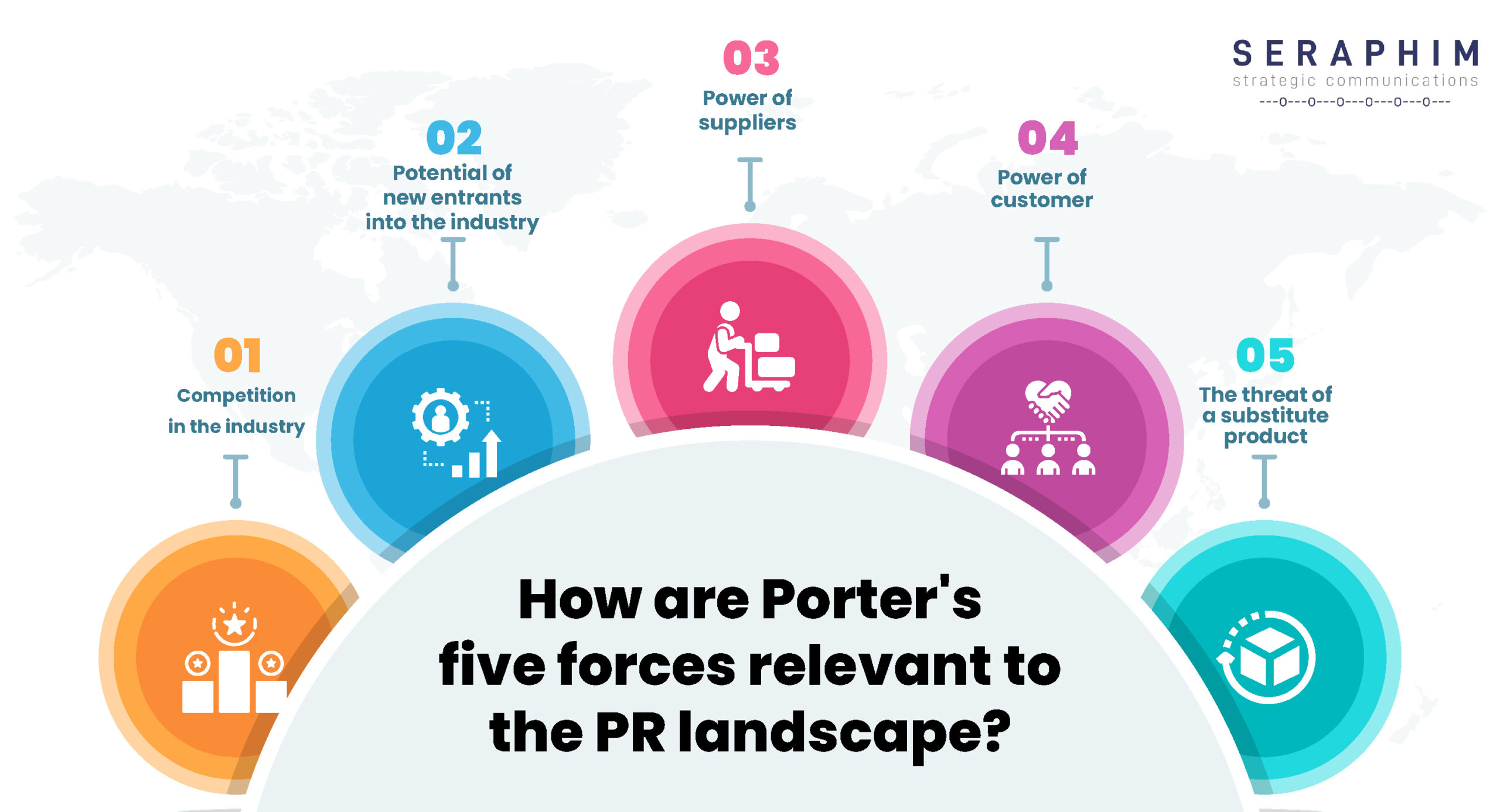
What are Porter’s five forces?
This model was first published in Michael E. Porter’s book, “Competitive Strategy: Techniques for Analyzing Industries and Competitors” in 1980 and is now used widely in the corporate world. In short, Porter’s five forces can be described as a tool to analyze a company’s competitive environment. It is important to analyze the competitive environment because the profitability of a company decreases as competition increases. These forces are also used to understand how different industries can sustain different levels of profitability. It is important for new and upcoming industries to keep these in mind because they’ll help them to adjust their strategy, boost their profitability, and stay ahead of the competition. Moreover, Porter’s five forces can be adapted to the Public Relations space as well in order to enhance the quality of consultancy for the client.
So what are these five forces?
1. Competition in the industry
This force evaluates the number of present competitors in the sector and their prominence. More competitors lead to a strategy in which companies attract customers by aggressively cutting prices and launching intense marketing campaigns. The more the rivals, the greater the competition, and any of these rivals can dominate the market. So, in such a case it is difficult to receive profits easily.
2. Potential of new entrants into the industry
This force analyzes the ease of entry for new participants in the industry. If the entry of new rivals is easy, then the competition in the sector is high. The entry of new rivals is difficult if the services of the company are unique and the protection of technology used is efficient. An industry where there are strong barriers to entry is ideal for the existing companies because they can charge competitive prices and negotiate better terms.
3. Power of suppliers
This force analyzes the ability of suppliers to drive up the cost of their inputs. This ability depends on the number of suppliers, the uniqueness of the inputs, and if it’s easy to switch to another supplier. If there are few suppliers, a company depends more on the supplier which leads to higher input costs and low profits for the company.
4. Power of customers
This force analyzes the ability of customers to affect prices. It depends on the number of customers a company has, the significance of each customer, and how much it costs to find new customers. A smaller customer base means each customer has more power to influence the prices, vis-a-vis if a company has a more extensive customer base, each customer would have less power to negotiate and influence the prices.
5. The threat of a substitute product
This force analyzes the substitute goods or services that are available in place of a company’s products or services which will eventually pose a threat. Companies that produce goods and services which are one of a kind with no substitutes will have more power to increase prices and get more profit. When multiple substitutes are available, companies will have to stick to low prices because customers have multiple options.
Porter’s five forces and the PR industry
This five force model is very relevant to the PR industry in two aspects, firstly, this model can be used in the PR industry to figure out the competitiveness within the sector and then create strategies for the same. Second, it is very useful for the PR industry to analyze a particular client’s competitive space to curate PR strategies for it.
Using the ‘five forces’ for a client: Enhanced SWOT
A PR firm will handle a company’s reputation through owned, earned, and paid communications. Public relations firms also handle messaging between the firm and the media. Porter’s five forces is a detailed analysis of the competitor as well as the policy space, which takes a simple SWOT analysis to the next level. Engaging in the five forces study will enable a PR company to deeply understand a client’s competitive space because it has to work on its image and protect its reputation.
The five force model helps to make new strategies on how the client can survive in its competitive environment and ringfence its reputation from the competitor’s image attack, misinformation, and fake news. Deeper news monitoring of new entrants in the sector similar to the client will also nudge a PR consultant to be more innovative in their approach to media while drafting content. Research on the client’s supply chain and media visibility of suppliers will help draft cohesive and comprehensive media strategies to make the key messages richer.
Just a mere threat part of a SWOT analysis won’t suffice when it comes to the threat of substitutes. In today’s times, when information is readily available and on your face, clients must rely on thorough media research by their PR colleagues to assess the risks of their business and be prepared for any reputational eventualities.
Porter’s five forces on the PR industry
1. There are a large number of competitors in the field, and competition in this sector is cut-throat
2. The PR industry is not capital intensive and has profitable markets, leading to easy entry of new rivals.
3. The PR industry focuses heavily on human resources, it is not capital intensive and does not rely on any type of particular supplier.
4. It depends from one PR firm to another on how much pressure is being put on them from their clients and what their client base looks like. So, it is difficult to categorize the power of customers as high or low.
5. The PR industry at present is an attractive field, with high profits and fewer capital incentives which leads to there being several substitutes available. So each company needs to highlight its uniqueness and make its presence felt.



